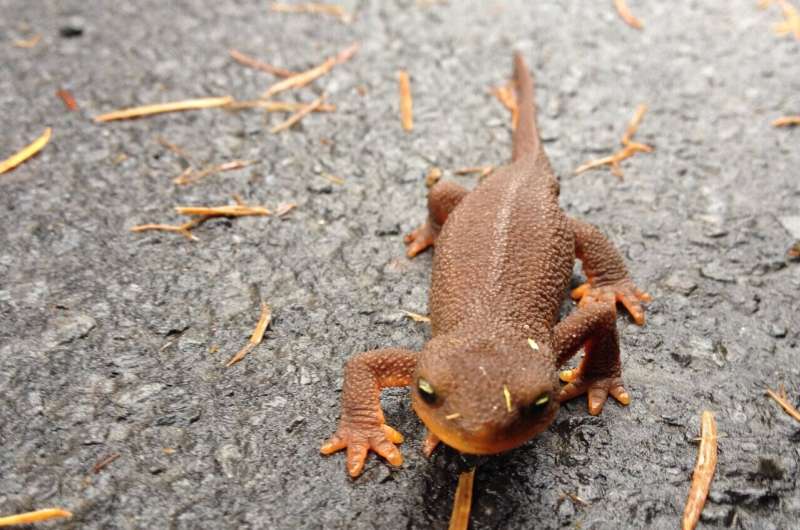
Amphibians—like frogs and salamanders—are the most imperiled group of animal species in the world; infectious diseases are among the greatest threats to their existence. After a decade of research, a scientific task force is poised to stave off these and other infectious threats to wildlife in North America.
In the late 1990s, an emerging infectious disease caused by the fungal pathogen Batrachochytrium dendrobatidis, or Bd, led to devastating amphibian losses in the United States and elsewhere. In 2013, researchers discovered a related pathogen in Europe—B. salamandrivorans, or Bsal.
A year later, researchers formed the North American Bsal Task Force to forestall invasion of the novel pathogen into North America. Today, the group’s work is helping keep Bsal at bay.
The task force, its accomplishments, and its insights—which can inform planning for other emerging wildlife diseases on the horizon—are highlighted in a new article in the journal, Frontiers in Amphibian and Reptile Science.
Proactive, preemptive planning
The North American Bsal Task Force is a collaborative team made up of volunteer members from across the United States, Canada, and Mexico. It includes eight thematic working groups that address research, decision science, diagnostics, surveillance and monitoring, data management, response and control, healthy trade, and outreach and communication.
The group’s mission is to advance knowledge and develop management actions to plan for the expected emergence of Bsal in North America.
“Our response to the amphibian disease caused by Bd was reactive, since the pathogen and disease were described years after population declines in Bd-susceptible amphibians were being noted worldwide,” said Dede Olson, a research ecologist at the USDA Forest Service Pacific Northwest Research Station, founding co-chair of the task force, and lead author of the new article.
“But when Bsal was discovered, it was not yet known to occur in North America, so proactive planning was possible.”
So far, according to Olson, Bsal has not been detected in North America, but laboratory trials have shown the threat is real.
“Thirty-five of 80 North American amphibians tested can be infected by Bsal.” Mortality, she added, occurred in about half of the infected species—in 16 of the 35. Like Bd, Bsal causes a lethal skin disease in amphibians that are susceptible to the pathogen.
Because Bsal is still relatively new to scientists and managers, the task force’s key goals have been multifaceted and evolving. The need to identify the pathogen’s characteristics and epidemiology, especially in disease-susceptible host species in North America, has been fundamental.
The group also is refining advanced diagnostic techniques because established methods of detecting disease-causing fungal pathogens may generate both false-positive and false-negative results.
The task force has developed a rapid response template to help guide resource managers on what to do if Bsal is detected. It has also established a surveillance and monitoring program to help serve as a first-alert system for possible cases. The program incorporates its survey data in a community-accessible database to support communication and surveillance across the continent.
Olson helped to migrate the legacy Global Bd Mapping Project to a combined global Bd-and-Bsal Amphibian Disease Portal, which is now the go-to data-management site for information on these two pathogens. The portal is operated by AmphibiaWeb and managed by task force partner Michelle Koo of the University of California, Berkeley.
“The partnerships developed by the Bsal task force community are pivotal across goals and working groups, and there are many ties to world experts addressing both Bd and Bsal diseases and amphibian conservation in general,” Olson said.
Looking to the future
In addition to answering fundamental questions about the threat that Bsal poses, such as how susceptible North America’s amphibian species are to the disease, the task force also has made strides in other areas.
Its work, for example, has informed import restrictions to limit introducing Bsal to North America through the pet trade, identified laboratories to test for the disease, and established a network of partners for sharing updates on Bsal developments.
“Our preparation for a Bsal invasion is far ahead of past experience with other amphibian-disease threats,” Olson said. And the group’s work continues.
What she and her colleagues have learned from a decade of preemptive planning can serve as a model for other strategies to manage wildlife threats, such as emerging diseases.
“Although the task force model certainly is applicable to emerging diseases in other taxonomic groups, it can also inform capacity-building strategies for collaborators to address any threat factor, advancing knowledge discovery and conservation efficacy,” she said.
More information:
Deanna H. Olson et al, Preparing for a Bsal invasion into North America has improved multi-sector readiness, Frontiers in Amphibian and Reptile Science (2024). DOI: 10.3389/famrs.2024.1347541
Citation:
Bsal and beyond: Task force helps stave off amphibian disease threat (2024, May 7)
retrieved 8 May 2024
from https://phys.org/news/2024-05-bsal-task-stave-amphibian-disease.html
This document is subject to copyright. Apart from any fair dealing for the purpose of private study or research, no
part may be reproduced without the written permission. The content is provided for information purposes only.







